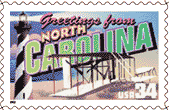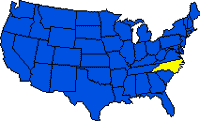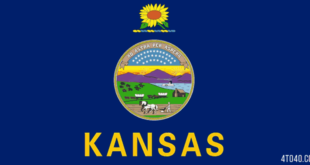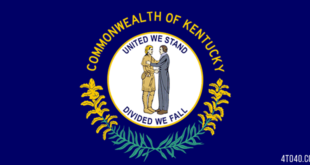North Carolina State, occupies a median location along the Atlantic seaboard and is bounded on the south by South Carolina and Georgia, on the west by Tennessee, on the north by Virginia, and on the east by the Atlantic Ocean.

In area, the state ranks 28th, and in population it ranks 10th. RALEIGH is the state capital. North Carolinians are called Tar Heels, a nickname the origin of which is still debated. One of the first English colonies, the area was named for Charles I in a charter of 1629. With its involvement in both the Revolutionary and Civil wars, North Carolina has a rich historical tradition on which, in part, a growing tourist industry is based. Traditionally agricultural with many tobacco plantations, the state was one of the first in the South to industrialize and now ranks high in industrial output.
North Carolina State: Land & Resources
North Carolina State is divided into three main physical provinces: the coastal plain, the Piedmont, and the mountains. The eastern boundary of the coastal plain is a chain of barrier islands, the Outer Banks, separated from the mainland by lagoons and salt marshes. The miles of beaches are geologically ephemeral and ecologically vulnerable. The coastal plain is divided into the Tidewater area, which is quite flat, poorly drained and often marshy, and the inner coastal plain, which is higher, better drained, and better suited for agriculture.

The coastal plain merges with the gently rolling PIEDMONT at the FALL LINE, where the change in slope made navigation more difficult and waterpower a possibility. Raleigh, like many important East Coast cities, lies near the fall line. The Piedmont elevations range from 90 to 180 m (295 to 591 ft) in the east to 457 m (1,500 ft) at the Blue Ridge. The Piedmont encompasses about 45% of the area of the state, about the same percentage of the total area as the coastal plain.
The BLUE RIDGE MOUNTAINS, the beginning of the mountain province, rise above the Piedmont. In North Carolina the Appalachian chain reaches its zenith. More than 40 peaks are higher than 1,830 m (6,000 ft), and Mount Mitchell, at 2,037 m (6,684 ft), is the highest peak east of the Mississippi. The rounded contours of these very old mountains testify to long periods of erosion.
Climate:
The climate of North Carolina State is generally mild, especially on the south coast. In the mountainous west the winters are more severe, but the summers are relatively cooler. The mountains shield the state to some extent from cold fronts coming from the north or northwest, and the ocean tempers the climate of the east. January mean temperatures are 5 deg C (42 deg F), and July temperatures average 24 deg C (75 deg F). The state is well watered, with from 1,016 to 2,032 mm (40 to 80 in) of rainfall yearly. The coastline is occasionally hit by hurricanes, especially on the Outer Banks.
Historic Sites:
The long and rich history of the state has been preserved in a number of outstanding historic sites. The mystery of Sir Walter Raleigh’s colony on Roanoke Island has been memorialized in an outdoor drama entitled “The Lost Colony”, and the fort has been rebuilt. Tryon Palace, the English governor’s residence at New Bern, has been called the most beautiful building in the colonial Americas. The Moravian settlement of Old Salem has been restored. On the Outer Banks the Wright Brothers National Memorial commemorates America’s first sustained flight.
Tourism:
The state’s beaches and mountains have provided variety for North Carolina vacationers. Tourism has become one of the largest industries in the state. Outdoor recreation facilities attract most visitors.
North Carolina Blue Ridge Mountain Country in 4k
North Carolina State: History
Although human settlement dates from 8000 BC, the first Europeans to visit the North Carolina coast were French explorers led by Giovanni da VERRAZANO in 1524. In 1526 a group of Spanish sailors established a temporary colony of more than 500 persons, probably at the mouth of the Cape Fear River. A 1540 expedition by Hernando DE SOTO crossed what is now western North Carolina before turning west to discover the Mississippi River.
First in Victory: North Carolina’s role in The American Revolution
It was the English, however, who made the first permanent European settlements in North Carolina, and the Roanoke Island settlement (1585-86) of Sir Walter RALEIGH was the first English colony in the New World. A second group set sail from England in 1587 but had vanished by 1590 when a supply ship arrived. The mystery of the colony’s disappearance has never been solved. Among the settlers was the first child born of English parents in America, Virginia DARE.
More than 150 years passed before settlers moved inland across the state–from the northeast corner in 1670 to the westernmost tip in 1820. The early European settlers came in contact with a number of Indian tribes as settlement spread westward, the most numerous groups encountered being the TUSCARORA. The natives occupied parts of the coastal plain and fiercely resisted the whites before being defeated in 1713, after which they returned to New York, their ancestral home. The CATAWBA of the southern Piedmont were friendly. The Cherokee, living in the Appalachian Mountains, were the last major tribe to be confronted by the settlers.
Proprietary Period:
The colonial period from 1663 to 1729, known as the proprietary period, began when Charles II granted to eight lords proprietors that region lying between 31 deg and 36 deg north latitude and extending from the Atlantic Ocean to the South Seas. This region was later (1665) extended to 36 deg 30 minutes N to include the Albemarle settlers who had moved south from Virginia. Political strife and Indian wars slowed the colony’s growth, however, and as the Charleston settlement grew more rapidly, the territory began to be known as North and South Carolina. The northern territory was made a separate colony in 1712 and had its own governors until 1829. This boundary was not established until 1735, nor fully surveyed until 1815. This period was characterized by misgovernment, turmoil, and slow growth. Piracy and disputes with Virginia over tobacco shipments through Virginia ports hampered trade. Bath, near the mouth of the Pamlico River, was the first town to be incorporated (1706). Settlement was generally confined to the coastal areas.
Royal Colony:
In 1729, North Carolina became a crown colony when George II purchased the shares of Carolina from all the lords proprietors except Lord Granville. Until the outbreak of the Revolution in 1775, a more efficient government brought about increased settlement and greater prosperity. The population increased from 35,000 in 1729 to almost 350,000 in 1775, and settlement extended to the Blue Ridge Mountains and beyond. With this transmontane movement came the deep-seated differences between east and west that have continued to the present day. The colonial government was dominated by the eastern planters, and the more egalitarian and poorer west suffered from corrupt government and excessive taxes. The conflict resulted in the War of Regulation (see REGULATORS), in which the western insurgents were crushed by Gov. William Tryon (1729-88) at the Battle of Alamance Creek on May 16, 1771.
In 1747-48 the Spanish attacked the North Carolina coast. Troops from North Carolina assisted British troops in the capture of Fort Duquesne during the FRENCH AND INDIAN WAR (1754-63) and fought the Cherokee on the western frontier in 1760. Yet, North Carolina was among the leaders in resistance to British rule in the 1760s, and in 1765-66 its armed citizens prevented enforcement of the STAMP ACT in the colony.
The American Revolution:
British rule came to an end in North Carolina when Gov. Josiah Martin fled New Bern in May 1775. The Second Provincial Congress in 1775 established two regiments and a state government. The first battle of the Revolution in North Carolina was fought against Scottish Loyalists at Moore’s Creek Bridge on Feb. 27, 1776. Later that year the Fifth Provincial Congress adopted a state constitution and elected Richard Caswell the first governor. North Carolina was the first colony to declare officially its readiness for independence and in April 1776 furnished ten regiments to the Continental army, as well as thousands of militiamen. At the same time, it helped defeat the Cherokee and suppressed the Tory residents who made the revolution virtually a civil war in North Carolina. Despite its leadership in the Revolution, North Carolina was the next to last of the 13 original states to ratify the federal Constitution (November 1789). In 1789, North Carolina ceded its western territory, present-day Tennessee, to the federal government.
The 19th Century:
The period from 1815 to 1835 was one of political and economic stagnation, with the oligarchic east in power at the expense of the more reform-minded west. The state’s convention of 1835 resulted in a reapportionment that gave the west control of the state house of representatives, leaving the east in control of the senate. From 1835 until 1860 progress in transportation, education, tax reform, and women’s rights, as well as agricultural expansion and greater prosperity, reversed the downward political and economic spiral and halted emigration west or south.
The CIVIL WAR brought this improving trend to an end. North Carolina, though sympathetic to the South, was the last state to secede, on May 20, 1861. The battles of Fort Hatteras, Plymouth, Fort Fisher, and Bentonville, as well as Sherman’s 1865 invasion and Johnston’s surrender to Sherman near Durham on Apr. 26, 1865, were the most notable Civil War events in North Carolina. The political and social disruption caused by the war were exacerbated during RECONSTRUCTION. The Democratic party regained control of the legislature in 1870 and removed from office Gov. W. W. Holden, electing Z. B. Vance in 1876 to end the Reconstruction period in the state.
In 1880 the state began to industrialize and to urbanize for the first time. The new industrialization (called the First Cotton Mill Campaign) brought additional jobs to the Piedmont but only modest prosperity because of low wages. Agricultural production increased, but farmers were burdened by low prices, heavy debt, and widespread farm tenancy. By the turn of the century, major advances were made in the educational system, which had virtually collapsed during Reconstruction. World War I boosted the economy and led to the establishment of important military bases, including FORT BRAGG.
Modern Period:
During the early 1920s an exodus of textile mills from New England to the Carolinas took place, reforms in state government were instituted, and extensive construction projects began. Even during this period of prosperity, however, personal income still lagged, averaging only about half of the national mean. The Depression of the 1930s struck North Carolina early, and New Deal programs, particularly farm price supports, were important to economic recovery. World War II also gave the state’s economy a boost.
North Carolina has profited in recent years from its location in the Sun Belt, though problems still remain. Incomes are still low, agriculture remains dominated by tobacco, and the state’s national primacy in textiles is vulnerable to foreign competition. Despite these problems, its people have probably never been better prepared to face the future.
North Carolina State: Land
- Area: 139,397 sq km (53,821 sq mi); rank: 28th.
- Capital: Raleigh (1990 pop., 207,951).
- Largest city: Charlotte (1990 pop., 395,934).
- Counties: 100.
- Elevations: highest–2,037 m (6,684 ft), at Mount Mitchell; lowest–sea level, at the Atlantic coast.
External Links:
- North Carolina Top 10 Exhibitions
- North Carolina Top 10 Travel Events
- North Carolina Top 10 Textile Trade Fairs
Business Events Happening In North Carolina:
- Downtown Raleigh Home Show: North Carolina, United States
- Greater Charlotte Home and Landscape Show: Concord, NC
- Greensboro Ideal Home Show: North Carolina
- Southern Christmas Show: Charlotte, North Carolina
 Kids Portal For Parents India Kids Network
Kids Portal For Parents India Kids Network










